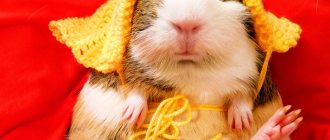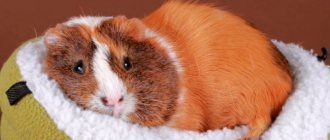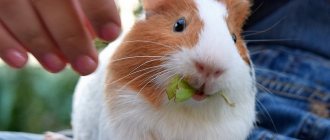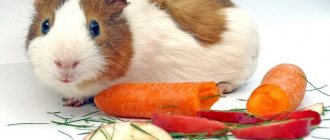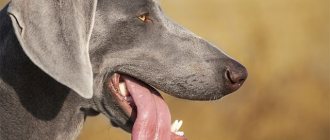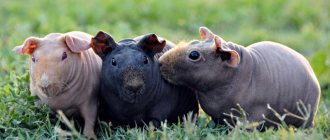Origin story
These animals have been domesticated since the 5th millennium BC. tribes of South America. The ancestors of the current inhabitants of southern Colombia, Peru, Ecuador and Bolivia are known to have eaten these mammals. Scientists believe that wild guinea pigs wanted to be around people without coercion. The Incas used guinea pigs as sacrificial animals, so they were constantly sacrificed to the sun god. Spotted brown or pure white animals were very popular. It is generally accepted that modern guinea pigs descended from their ancestors Cavia aperea tschudi, living in mountainous regions.
Guinea pig on the grass
Interesting to know! These mammals form small groups and live in fairly large underground burrows. Animals living in the mountains of Chile look completely different from domestic guinea pigs. This is because their food is low in water but rich in cellulose compounds.
Version of the priests' conspiracy
In an attempt to circumvent the restrictions on eating meat during Lent, Catholic priests came up with all sorts of things. So cavy (another name for our pets) was included in seafood.
Of course, it was difficult to do this unnoticed. Therefore, they came up with the following reason: cavy were imported along with capybaras (rodents with a semi-aquatic lifestyle). On this basis, the priests classified pigs as... fish. And they decided to call them sea - to explain their actions.
The story may seem crazy, but many foods from the New World bypassed the prohibitions on consumption during Lent. For example, cocoa, although it can hardly be considered an abstinence food.
Characteristics of a guinea pig
- Guinea pigs belong to the class of mammals and the order of rodents.
- They reach a body length of 22 to 35 centimeters and a weight of about 800 - 1200 grams.
- The gilt is pregnant for about 70 days, and a litter usually produces up to four babies.
- The standard lifespan of a guinea pig is 7 to 9 years, but there are individuals that live longer.
- The guinea pig's body is stocky, ending in a large head with no visible neck.
Guinea Pig Behavior Information
- Although guinea pigs are very territorial and can be aggressive in their natural habitat, pet pigs are usually very affectionate, and those who spend time with their owner often develop a strong emotional connection with them.
- Guinea pigs are characterized by a joyful whistle as a sign of greeting the owner or an enthusiastic reaction to an open treat or food.
Appearance
Guinea pig with apple
It is believed that the anatomy of a guinea pig is similar to most domestic animals. There are some differences noted:
- Guinea pigs have a cylindrical body. The body length does not exceed 22 centimeters, although there are also people of greater length.
- The animal's spine consists of seven cervical vertebrae, twelve thoracic, six lumbar, four sacral and seven caudal.
- The guinea pig does not have a tail or collarbones as such.
- Males are slightly heavier than females, and adults weigh from 0.7 to 1.8 kg.
- Guinea pigs have relatively short legs and their front legs are much shorter than their back legs.
- The front paws have 4 toes and the hind paws have 3 toes. The fingers are more like hooves.
- Over the course of a week, pork hair increases by about half a centimeter.
- Guinea pigs have sebaceous glands in the sacrum and paranoid glands in the genitals and anus, which secrete a special secretion.
- The guinea pig has a relatively large head with a well-developed brain.
- Animals' incisors grow throughout life at a rate of up to 1.5 millimeters per week.
- The guinea pig's lower jaw can move in any direction.
- The intestines are long enough to exceed the size of the animal's body, so food can take a week to digest.
Animals can vary in hair color, texture and length due to basic natural characteristics, so there are individuals with quite short, very long, straight or wavy hair.
Behavior and lifestyle
In the wild, wild guinea pigs prefer to be active at both dawn and dusk. Despite their size, they run very fast and are considered very agile and always alert.
The wild guinea pig lives in both forest and mountain areas. To build a nest, they look for quiet and secluded places, but do not dig holes. To create their home, they use dry grass, fluff and thin branches of trees and shrubs.
Interesting moment! Decorative guinea pigs are not only used as cute creatures to decorate the human home, but are also included in various research institutions as experimental animals.
Wild animals are quite sociable, so they live in the same territory with many of their relatives. Each herd has several males, the number of males for a couple of dozen females. These animals are quite active, so home breeding requires sufficient walking space. Pets rest (sleep) more than once a day, often with their eyes open.
How long does a guinea pig live?
In the wild, wild guinea pigs can live up to 7 years, but at home, if all rules and regulations are followed, they can live twice as long.
Guinea pig breeds with photos
Expert opinion
Nastya Shulepina
I love helping animals and writing about them. Veterinary resuscitator.
Ask a Question
Guinea pigs are quite popular pets, so many new breeds have been artificially bred recently. Below I have made a selection of the most popular breeds today.
Alpaca
Guinea pig on the grass Alpaca breed
This breed is characterized by the presence of thick, beautiful, curly and long hair. These pigs have two rosettes on their backs and one irregularly shaped one on their foreheads. In the area of the muzzle, the fur grows, forming a kind of sideburns. Hair grows on my legs.
Texel
Guinea pig on the grass of the Texel breed.
This breed is characterized by thin curly hair, similar in appearance to wet Permian. Thanks to their unique and attractive wool coat, this breed is very popular at home and abroad.
Abyssinian
Abyssinian guinea pig on the grass
is considered one of the oldest and most beautiful breeds. This breed has a hard coat, as well as several rosettes consisting of rather long hairs. These animals have an excellent appetite, and the animals themselves are very active.
Merino
Merino Grass Guinea Pig
This breed has many traits, including large eyes and ears, as well as a short head and strong, compact body. The breed has long and curly hair, well-developed cheeks and pronounced whiskers. He has a symmetrical small crown on his head.
Peruvian
Peruvian guinea pig on grass
The breed has long and very attractive hair that does not require special care. To prevent hair that is too long from being too dirty, guinea pig owners use special curlers.
It is a variety of short-haired breeds that have a special fur structure. As a result, the guinea pig resembles a small living plush toy. The fur on the back and head is coarser compared to the rest of the body.
Cornet
Guinea pig on the grass of the Cornet breed.
This breed has other names, such as “Crested” or “Wearing a Crown”, which is associated with the animal wearing a kind of crown between its ears, formed by a special rosette. The coat is long and evenly distributed over the body. The Cornet is the result of crossing the Sheltie and Crested breeds.
Sheltie
Guinea pig on the grass Sheltie breed
She has long straight hair with a silky shine. The head has a characteristic mane that goes down to the shoulders and back of the animal. The animals are born with short hair, but in just six months they develop a full coat.
Baldwin
Baldwin Guinea Pigs
Interesting to know! Baldwin guinea pigs have a very exotic and unusual appearance because they have no fur. The animal has several hairs of medium length on its knees. In general, they look like small hippos.
Self
Guinea pigs of the Self breed
Self is considered the most popular breed of short-haired guinea pigs. This breed has a solid color, and the number of colors is amazing. At the slightest movement of the animal, many tones are reflected, which creates unique shades of colors.
Links[edit]
- "Livestock Protection". livestockconservancy.org
. Retrieved March 10, 2022. - Kirk, p.103.
- "AHA".
- ^ a b Doner, 2001.
- ^ a b "Protection of livestock". livestockconservancy.org
. - Nabhandr., p.74.
- Nabhan and Dohner 2001 - 1991, although on the official website of the Association it is 2005.
- "Ark of Taste: Guinea Pig". Slow Food USA.
- “American Guinea Pigs | Lincoln Park Zoo". www.lpzoo.org
. - Malagon, Elvia. "Chicago man, self-described Satanist, loses final battle to remove 'In God We Trust' from US money". chicagotribune.com
.
Keeping at home
Spotted Guinea Pigs
Once an animal is captured, its behavior can be quite slow and unconvincing as the animal gradually becomes accustomed to its new environment. During this period, the guinea pig has a poor appetite, it is afraid of various movements and sounds, so it can sit motionless in one place for a long time. The adaptation process can and should be accelerated by creating a calm and attentive atmosphere in the house.
Cage, filling
Guinea Pig Cage
In fact, guinea pigs are considered to be quite shy by nature, which is why they react negatively to changes in their environment. Animals can be kept either in a terrarium or in a cage with a tray, the latter is preferable. The cage should be equipped with some kind of country (sleeping) house, as well as various game elements, a feeding trough and a drinking bowl. Naturally, the size of the chicken coop should take into account the size of the animal itself.
Care, hygiene
Caring for a guinea pig
Guinea pigs do not tolerate both cold and excessive heat in the form of direct sunlight, so it is necessary to protect the animal from these negative factors. Water treatments should be organized according to the needs of the guinea pig. The coat should be brushed once a week. Since nails are unlikely to shrink naturally, they should be trimmed once a week.
If an animal participates in exhibitions, it requires special attention. From the youngest For years, they need to be taught to sit quietly in one of the postures and patiently endure the daily process of brushing their teeth. In this case, the animal must withstand the process of applying the pin. Sea rabbits with coarse and smooth fur undergo periodic trimming.
What to feed
Three guinea pigs nibble on tasty green grass.
In the wild, guinea pigs eat plant components, including plant roots and seeds, leaves and fruits fallen from trees or shrubs. The basis of a guinea pig's diet is high-quality hay, which normalizes the functioning of the digestive system and also allows rodents to grind their teeth. Due to the specifics of the digestive system, hay should be given to animals quite often, but in small portions.
Attention! Experts recommend feeding guinea pigs with ready-made food, in an amount of no more than one tablespoon per day.
Of course, no one will feed a guinea pig exclusively with hay, so its diet should include juicy food in the form of berries, fruits and vegetables. Sweet fruits, berries and fruits from other crops can be offered as treats. To grind down permanent teeth, your guinea pig should be given cherry or apple sprigs, dandelion root or celery. Your guinea pig's cage should have fresh, clean water, which should be changed daily.
Guinea pigs are purely herbivores, so any animal products should be excluded from the diet. In addition, it is not recommended to feed guinea pigs milk, as this can lead to disturbances in the animal’s digestive tract, since its body is poor in digestive lactose. The consumption of low-quality feed, as well as frequent and, moreover, rapid changes in the diet, contribute to the development of various ailments, and often cause death.
Health, diseases and their prevention
The most common diseases that guinea pig owners may encounter are:
- Worms and external parasites.
- Alopecia or baldness, which occurs as a result of improper feeding of the animal, manifests itself in stress, lack of vitamins and minerals, and the appearance of parasites.
- Injuries and even fractures of limbs, which is associated with violation of maintenance rules.
- Rickets as a consequence of vitamin D deficiency.
- Colds (acute respiratory infections), pneumonia, inflammation of the ear and bladder as a result of hypothermia or drafts.
- Anomalies of dental incisors.
- Digestive system disorders. As a result, the animal develops diarrhea, constipation, gas or enteritis.
- Cornea and conjunctivitis as a result of infection, chemical and mechanical factors.
Improper nutrition (nutrition imbalance) leads to obesity in the animal, which does not lead to anything good.
Reproduction and offspring
At the age of six months you can start breeding guinea pigs. This process is possible within 2 weeks, with the possibility of fertilization within 8 hours. After the start of pregnancy, the female carries her future offspring for about 2 months.
In this way, from 2 to 5 cubs are born, which are well developed and move independently. Nurses feed the cubs for several months, but no longer.
What is necessary?
To ensure decent living conditions for your pet, you need to purchase the following equipment:
A cage. It should be spacious, since this is the animal’s only home. For one pig, its size should be at least 90 x 60 cm. It is advisable to keep guinea pigs in same-sex pairs, since they need communication with their relatives, so the optimal cage size for two animals should be at least 120 x 70 cm. Instead of a cage, you can use a rack or pen on the floor, but they must also be spacious enough and not resemble a punishment cell.
- A house or hammock for the animal to have its own shelter. Pigs are very shy, so they need a place where they feel safe.
- Feeder and drinker, which should be designed specifically for rodents. The feeder should be difficult to knock over, and there should always be fresh water in the drinker.
- Litter. For these purposes, it is prohibited to use cotton wool, paper or newspapers, as they can be very harmful to the animal. A thick layer of sawdust or pressed granules is used in combination with a PVC mat. You cannot use granules exclusively, as they can lead to problems with the animal’s paws.
The list of necessary things should include a carrier, which may be needed when visiting a veterinarian (rodent specialist - ratologist), a comb for long-haired breeds, as well as toys - balls, tunnels. By the way, it is forbidden to use a hamster wheel as a toy, since the pig’s spine is quite weak and is not designed for such loads. For the same reason, it is not recommended to use leashes and harnesses.
Where and how to buy a guinea pig
Generally, show and breeding animals are the most expensive, as they compete in shows and are the backbone of any breeder or breeder. Pets in the class are inexpensive and available to citizens of all categories.
The cost of animals includes various factors such as sex, quality, color and origin. Imported animals cost at least 15 thousand. rubles, because transportation is not cheap at all. Despite its origin, the pig must be absolutely healthy, well-fed and very active. The eyes and nose should be clean, and the coat should be well-groomed, without ridges or bald spots.
Other reasons
In some cases, a furry rodent twitches and jumps for completely different reasons. To determine them, the owner should remember events related to the pet that could please him. The animal can rejoice at the received treat or fresh tasty grass. If he has recently been walked outdoors, this may also cause unusual behavior.
It may have to do with the conditions in which the animal is kept. A rodent cannot warm up if it is in a cramped room. He needs more space to play. Due to the lack of active movements, the pet lies on its side and twitches. To change the situation, a caring owner must increase the space by adding toys, wheels and tunnels.
Owner reviews
Naturally, elite guinea pigs are not available to the average buyer. In any case, if you plan to breed them, purebred specimens should be selected.
Interesting to know! Experimental research on rabbit breeding in our country has not yet reached such a high level as abroad. And yet, true connoisseurs of these animals try to buy individuals with an attractive and exotic appearance.
It should also be remembered that long-haired and short-haired breeds cannot be crossed, as the result will be offspring that are of poor quality crossbreeds, and no one will allow them to put on a show. Moreover, crossing different breeds is also unacceptable. and because it prevents the improvement of the racial data of both species.
Guinea pigs have earned the right to be considered one of the most wanted pets. Ease of care and maintenance is acceptable for everyone, even novice owners. This is an affectionate and sociable animal, great for families with children.
When to contact a veterinarian
By carefully observing the animal, you can determine its condition and notice the onset of diseases in time. Sometimes the reasons for overexcitement of a rodent inside the home are so serious that it is impossible to do without the intervention of a doctor.
An alarming sign is the animal running and stopping to gnaw at the bars of the cage. This behavior indicates serious dental problems. In this case, contacting a doctor is mandatory.
It’s even worse if the animal is lethargic but restless. For example, when a guinea pig lies on its side, twitching its paws and head, this is a reason to be seriously alarmed. With this behavior of the animal, there is a high chance of contracting helminthiasis or gastrointestinal pathology. The rodent should be taken to the vet immediately.
It happens that a guinea pig jumps and twitches because it is bothered by itchy skin. The cause of the disease is lice-eating parasites. When examining the fur, skin redness and peeling may be detected. If no measures are taken, wounds will form in these areas. The sooner the animal gets to the veterinarian and begins treatment, the shorter the entire period of getting rid of parasites will be.
When buying a guinea pig, you need to find out how often the previous owners worked with the animal, what they taught it. Then it will be easier to draw conclusions about the reasons for changes in the pet’s behavior.
It is normal for most of these rodents to express their joy through popcorning, and this occurs in all known breeds. Therefore, if your pet is healthy, he has enough movement and jumps up, just be happy.
Frequently asked questions and answers:
Where did guinea pigs come from?
Guinea pigs originate from the Andes Mountains in South America, where they are treated as farm animals, like rabbits, and as food.
What breeds of pigs are there and how do they differ? Can they be identified only by appearance, or also by behavior?
- Short-haired pigs include: smooth-haired, rosette (Abyssinian), American Crested, English Crested, Rex, Teddy. Longhair breeds include Sheltie, Coronet, Angora, Peru, Texel, Merino, Alpaca and Mohair. All breeds have different colors.
- There are breeders who claim that there are visible differences not only in the appearance, but also in the behavior of individual breeds of pigs, but this has never been confirmed. Of course, a lot depends on the approach and breeding methods.
How long do guinea pigs live?
- Guinea pigs live relatively long: 5-8 years and even longer.
- The record holder was the pig Snowball from England, who lived for 14 years and 10 months. This record was included in the Guinness Book of Records.
Where is the best place to buy pigs and how do you know if they are healthy?
- It is best to get a guinea pig from a breeder.
- Don't be afraid to ask him specific questions. Any serious breeder will be happy to answer any question.
- You should also look inside the cages to make sure they are clean, spacious and bright, and that there are not too many pigs sharing the same cage.
- A healthy pet guinea pig has shiny fur and eyes and is not skinny.
- Her fur is not thin and does not tangle.
How to find out the gender of a guinea pig?
- This is not easy for the untrained eye.
- The sex of a pig is best diagnosed by comparing individuals of the same sex.
- To determine the sex, carefully pick up the guinea pig so its belly is visible.
- Then gently stretch the skin around your genitals with your fingers.
- If the organ looks like the letter “Y”, the pig is female, if it looks like the letter “I”, it is male.
What should your pet guinea pig eat every day?
- Your pet guinea pig should be given dry food, hay and fresh drinking water daily.
- In addition, vegetables and fruits will provide good nutrition. A guinea pig should not be fed rabbit food.
- Pigs are at risk of vitamin C deficiency because, like humans, they cannot produce it themselves. This vitamin is found in ready-made food for guinea pigs.
What should you not give your guinea pig to eat?
Expert opinion
Nastya Shulepina
I love helping animals and writing about them. Veterinary resuscitator.
Ask a Question
Under no circumstances should you give your guinea pig any sweets: ice cream, chocolates, sweets, etc., cabbage (causes flatulence)
How big should a cage be for two guinea pigs?
The smallest cage size for two animals is 100 x 60 cm. After all, pigs spend most of their time in a cage, so they need to be able to move around normally.
How to prepare a play area for a guinea pig?
For places where you can play, your imagination should have no boundaries - boxes, pipes, ramps. Your guinea pig will enjoy playing even more if there are small treats between the obstacles, such as a slice of cucumber, parsley root or a piece of paprika.
Can a guinea pig live outside?
Just like rabbits, in principle, a guinea pig can be kept in a cage outside. Guinea pigs should go outside anyway in the summer to properly shed their winter fur. In winter, the cage must be insulated and completely covered, for example, with plexiglass. An additional bedding of hay is also useful so that the animal can cover itself with it. Also, check your drinking water regularly to make sure it is not freezing.
What should you pay attention to when walking your pig outside?
- Please note that the street is sufficiently protected from dogs and cats.
- Never leave your pig on the ground while it is still cold or the grass is wet with dew.
- Your pig's first walks outside should not take too long to get him used to the grass and other outdoor vegetation and other inhabitants.
- It is best to feed frequently with green food from the very beginning.
How to pick up a guinea pig?
- To lift your guinea pig, it's best to use both hands and grab it in a criss-cross pattern under its belly.
- Then you can put it on your lap, or carry it on your chest.
- Be careful that the pig doesn't fall!
- She may look strong, but her bones are fragile.
- For example, falling off a sofa can cause serious injury.
How to make two guinea pigs friends with each other?
- The easiest way is to tame young animals to each other; with older ones this can be a little more difficult.
- To make them smell the same, you can lubricate them with fennel tea, then they should tolerate each other better.
- If you have two cages, you can keep them in separate cages next to each other for the first few days.
- Additionally, it is best to cage a newly purchased pig and then another pet in a regular cage to discourage them from being confident about their territory.
Can guinea pigs talk and what do their sounds mean?
- Guinea pigs make various sounds designed to attract the owner's attention.
- The most important one is the whistling sound that can be heard, especially when the guinea pig is enjoying the food being served.
- A guinea pig greets its human with a similar whistle.
- Another sound of pigs is a kind of “hum” that they make, for example, while petting their owner or during courtship.
- "Quileni" probably means sadness, but it is a mystery to experts who cannot explain how pigs make this sound.
- In addition, your pig may grind his teeth, which sounds a bit like growling.
- Grinding often happens when two men are arguing.
Is it possible to train a pig to be orderly?
There are guinea pigs that take care of their litter box needs like cats. To teach these animals such purity, training must begin at a very early age. Place your pig in the litter box, talk to her in a friendly manner, and pet her to create a positive association with the area.
How long can I leave my guinea pig alone?
- Sometimes long absences cannot be avoided.
- A guinea pig can be left alone for a maximum of two days as long as it is provided with sufficient food and drinking water.
My pig is not tamed, what should I do?
- Pay a lot of attention to this.
- Hand-fed treats such as fruits and vegetables can help with the taming process.
- You must be patient and devote time to your pet.
The nails are too long, how to trim them?
Because guinea pigs don't rub their nails well enough, they need to be trimmed regularly. You can take your pig to the vet, or do it yourself. Side cutters should cut the claw 3-5 mm in front of the innervated part. Light colored nails make it easy to see the nerves. Always trim dark nails from the very ends.
How to care for wool?
First of all, you should regularly check your fur for parasites. Firstly, long-haired pigs require regular grooming. They should be carefully combed with a soft brush. For curly coats, use your fingers to comb them gently so as not to hurt your pet with a harsh brush.
What to do if you have diarrhea?
Expert opinion
Nastya Shulepina
I love helping animals and writing about them. Veterinary resuscitator.
Ask a Question
In case of diarrhea, be sure to take your pig to the veterinarian because the pig has a very sensitive digestive system, the dysfunction of which can lead to serious intestinal damage.
The pig has an injured paw (a claw has broken off), what should I do?
It is best to dress the wound with a simple spray bandage to keep it clean. Then after some time the wound should heal without complications.
My pig's teeth seem too long, is this possible and what should I do?
In fact, some guinea pigs' teeth take too long to grow because they don't grind enough. Only a veterinarian can fix this. Pay attention to whether your pig is eating normally or whether food is not falling out of its mouth. Weigh your pig regularly (preferably once a week).
The pig throws food around, how to deal with it?
First of all, provide your pig with a stable and heavy bowl, such as for a rabbit. However, it should not be so large that your pig might mistake it for a litter tray.
What should I watch out for if I want to raise guinea pigs?
If you are thinking about starting a breeding farm, first consider what you will do with your mate's offspring. After all, a lot of domestic pigs are looking for a home and there is no one to care for them, as a result of which they end up in shelters or are simply thrown out.
- To get offspring of pigs, it is not enough just to let them get together. They should be closely monitored, weighed and fed carefully.
- After 68 days of covering, you can expect babies.
- After a maximum of four weeks, the young females must be separated from their father as he takes care of other offspring.
- A female for breeding should weigh around 700g and be between 5 and 11 months old when first mated. Before this, the pig's body was not yet developed - pregnancy can negatively affect its weight and height.
How to summon the spirit of a deceased relative?
Magic has always made it possible to penetrate into another world, summon the spirit of any deceased person and talk to him. But before the ritual you should think about the consequences
. Spirits don't always want to be disturbed.
It is better not to conduct such a dangerous ceremony yourself. You should trust a trusted medium in this matter. Only he can summon the necessary spirit. It is better to conduct spiritualistic seances in a relaxed state, with good thoughts.
You can summon the spirit yourself or seek help from a medium
Alternatively, you can use a Ouija board. Some tips to help summon the spirit of a deceased relative:
- Relax, throw away all your problems and worries, free your mind
- Don't be afraid. If the session is carried out incorrectly, an evil spirit will come. He will feed on your fears
- Before the session, fumigate the entire room with incense.
- It is advisable not to eat or drink anything on the day of the ritual, do not drink alcohol for 3 days
- call the spirit at night - after 12 and before 14 o'clock
- place wax candles in the room
- thread a black thread through a needle and make something like a pendulum
- on a piece of paper write down all the questions that you would like to ask the deceased
- call the name of the deceased and call to come
- if the needle begins to move, it means the spirit of the deceased is nearby. You can leave the window open, this will make it easier for the soul to get into the room
- If everything worked out for you and you received the answers, then do not forget to thank the spirit for coming and tell him that you are letting him go back
